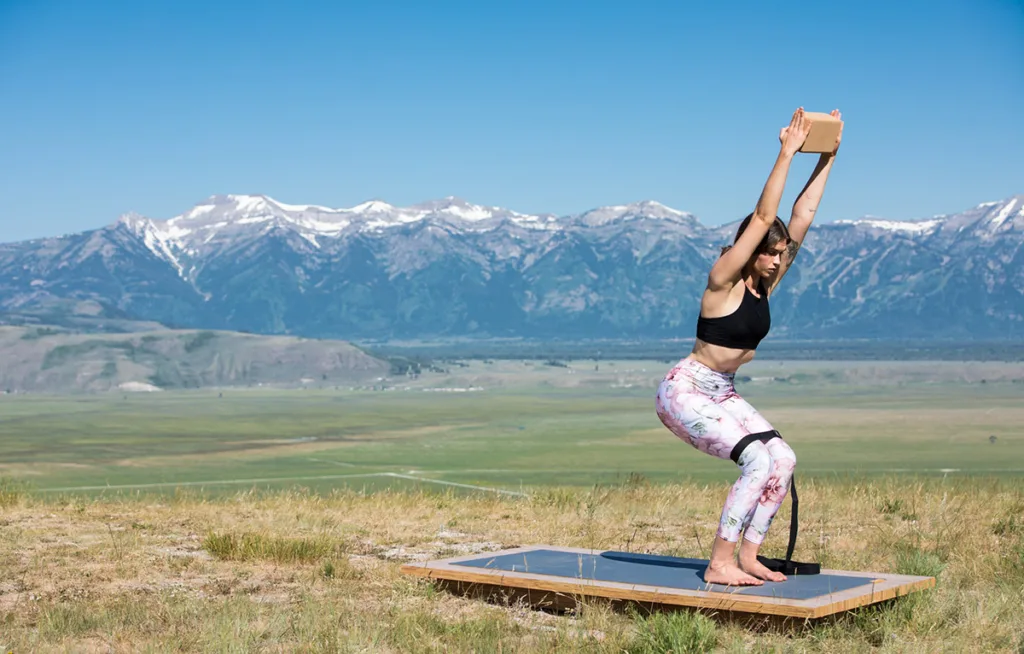
Flexible people tend to self-select for yoga. Of course, anyone, with any body type, can benefit from yoga practice. But those of us who were born with flexible bodies gravitate to the practice because asanas that highlight hypermobility—which make up the bulk of modern yoga poses—are easy for us. It wasn’t until it began to dawn on me that hypermobility is not a state of balance (inspired by bilateral hip replacements) that I began to appreciate strengthening poses more. Since then, Utkatasana (Fierce Pose) has become a regular part of my practice.
Utkatasana is a powerful, heat-building pose that engages pretty much the entire body. Practicing Fierce Pose strengthens the feet, ankles, legs, hips, core muscles (abs and back muscles), and the shoulders. In my experience, it seems to ground and focus my mind and to collect my body into a cohesive whole.
Utkatasana for Flexible People
I didn’t always love Utkatasana. Because it’s a strengthening pose, it always felt challenging. It didn’t have that effortless quality I loved in the poses that exploited my natural flexibility. But I’ve come to appreciate the stabilizing effects of the pose. And I can maximize the strengthening benefits by adding a Yoga Strap and a Yoga Block to my practice.
Hypermobile people tend not to recruit all the muscles, or the correct muscles, when challenging their strength. Consequently, some muscles become underdeveloped, and the ones that are taking up the slack can become overdeveloped. When we practice yoga, we often repeat our body’s familiar patterns in our poses. Using a Yoga Strap around our legs and a Yoga Block between our hands in Utkatasana helps us engage all the muscles necessary to find stability and ease in the pose.
Contraindications for Fierce Pose
Like all yoga poses, Utkatasana comes with cautions. People who are experiencing the following should avoid practicing the pose:
- Uncontrolled high or low blood pressure
- Headache
- Recent foot, ankle or knee problems
- Low back injury
Of course, many of these conditions are temporary, so you may need only avoid the pose for short periods. As always, pay attention to your body, not only while you’re practicing the pose, but also the next day. If your condition worsens immediately or a day after practicing the pose, that’s a clear signal to set it aside until your condition is healed.
How to Practice Utkatasana with a Strap and a Block
- Gather your props: a Yoga Mat, Yoga Strap and Yoga Block. Any type of Yoga Block will work, but remember that the Wood and Cork Yoga Blocks are quite a bit heavier than the Foam Yoga Blocks. For maximum arm strengthening, Wood and Cork blocks will demand more from your arms and shoulders. If you’re concerned about the possibility of dropping the block on your head, you might want to stick with foam.
- Step onto your yoga mat.
- Make a loop in your strap and then place the loop around your thighs, just above your knees. Tighten or loosen the strap so that it keeps your legs hips-width apart. Press your thighs into your strap to keep the strap from falling down.
- Standing in Tadasana (Mountain Pose), hold your block widthwise between your hands. Your arms can be extended downward in front of you.
- Now tilt your pelvis forward, sending your tailbone back so that your knees bend. Allow your torso to bend forward from the hip joints.
- Press your thighs into the strap. Do you feel more areas of your hips and legs engaging to support your pose?
- Pressing your hands into your block, raise your arms up toward the sky. As you press inward, notice what areas of the arms and shoulders are working.
- Stay in the pose for 3 to 5 deep, relaxed breaths or longer if you like.
- Return to Tadasana and relax your arms.
- Repeat the pose if you like.
For more information on healthy yoga practice for hypermobility, I highly recommend Libby Hinsley’s recent book, Yoga for Bendy People.
